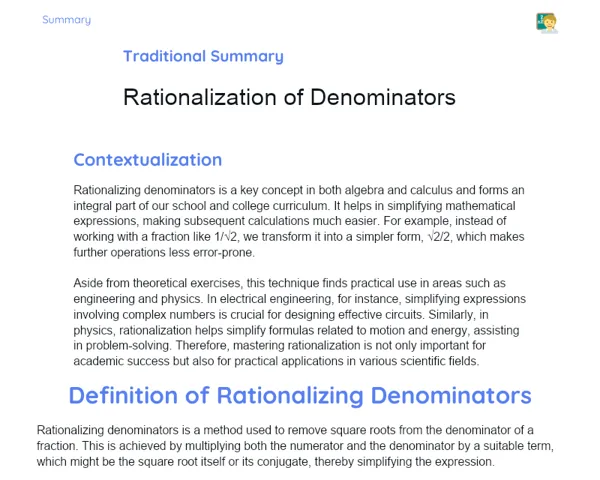Goals
1. Identify the main elements of a research study or chart, including the focus of the research and the titles.
2. Interpret data presented in tables and straightforward column charts.
Contextualization
Being able to read and interpret graphs and tables is a critical skill not just in mathematics but also in various everyday contexts. Picture yourself at a science exhibition explaining the outcome of a study, or perhaps watching the news where you see graphs depicting weather patterns or monthly rainfall. Understanding how to interpret this data enables you to gain a clearer view of the world and make informed choices.
Subject Relevance
To Remember!
Identifying Titles in Graphs and Tables
Recognizing titles in graphs and tables is vital for grasping the context and content of the presented data. The title generally provides a summary of what is being examined or measured, helping to guide the reader in interpreting the data effectively.
-
The title is usually positioned at the top of the graph or table.
-
It should be specific and informative, showing what is under analysis.
-
Without a title, accurate interpretation of the data can be challenging.
Understanding What is Being Researched
Grasping the focus of the research is key to accurately interpreting the data. This includes identifying the variables and elements involved as well as the research aim.
-
Recognize the primary variables at play in the research.
-
Understand the purpose behind the research and what it aims to uncover.
-
Acknowledge the significance of the gathered data and its intended application.
Reading and Interpreting Data in Tables
Reading and interpreting information in tables is about extracting useful and relevant insights from data organized in a grid format. This involves identifying the columns and rows, understanding the implications of the numbers and descriptions, and connecting this information back to the research topic.
-
Recognize the headings for columns and rows.
-
Comprehend the meaning behind the numbers and descriptions.
-
Align the data from the table with the research context.
Reading and Interpreting Simple Column Charts
Reading and interpreting simple column charts entails understanding how data is visually displayed through vertical bars. This includes identifying the variables on the x and y axes, interpreting the column heights, and relating this data to the research context.
-
Identify the variables on the x and y axes.
-
Interpret the height of the columns and their implications.
-
Connect the information in the chart back to the research context.
Practical Applications
-
Marketing professionals leverage graphs to analyse market dynamics and develop advertising strategies.
-
Engineers use graphs to track project outcomes and highlight areas needing improvement.
-
Doctors and researchers scrutinize graphs to understand study results and formulate treatment plans.
Key Terms
-
Graph: A visual depiction of data showing the relationships among various variables.
-
Table: A structured way of presenting data in rows and columns to simplify reading and interpretation.
-
Variable: An element or factor that can vary and be measured within a study.
Questions for Reflections
-
How does the ability to interpret graphs and tables assist you in making better decisions in day-to-day life?
-
Can you think of an instance where a graph or table helped clarify important information? Describe that experience.
-
In what ways do you envision this skill being advantageous in your future career?
Creating and Interpreting Your Own Graph
In this mini-challenge, you will get the chance to apply what you've learned about data collection, organization, and interpretation by creating a simple column chart based on your personal research.
Instructions
-
Select a topic for your research, such as 'favourite fruits,' 'favourite games,' or 'most common pets.'
-
Interview at least 10 classmates or friends to gather data on your chosen topic.
-
Organize the gathered data into a simple table.
-
Create a simple column chart to represent the data from your table.
-
Write a short paragraph interpreting the insights from your chart. What does it reveal? What conclusions can you draw from the findings?
-
Present your chart and analysis to a family member or friend and seek their feedback.



